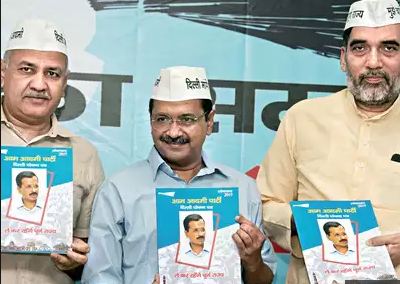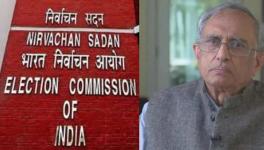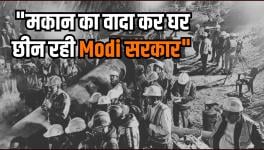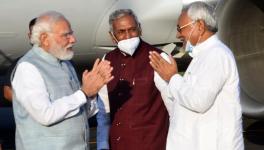Elections 2019: AAP Makes Full Statehood Its Poll Plank In Delhi

Image Courtesy: Bangalore Mirror
With the release of its manifesto for the Lok Sabha elections, the Aam Aadmi Party has made the demand of full statehood for Delhi its prime campaign plank. The party, which has been locking horns with both the Congress and the Bharatiya Janata Party (BJP), argues that a slew of issues, including expansion of health and education infrastructure, remain unresolved as they are directly linked to the complicated web of administrative powers in the hands of at least four local governments.
The consistent tussle between the Lieutenant General, who represents the Centre in Delhi, and the office of the Chief Minister was first evident in February 2014 when the Delhi Government cleared Jan Lokpal Bill and sent it for approval by then-LG Najeeb Jung. He forwarded the bill to the Ministry of Law and Justice for its advice, which suggested that it could not be passed without the consent of the central government. Failing to realise his promise of the Jan Lokpal, Arvind Kejriwal resigned, which resulted in the end to the party’s 49-day government.
The episode also triggered the demand that the resolution of issues in a state where the population has grown multifold requires a machinery that can look beyond the boundaries of Lutyens’ Delhi. The bickering continued after the AAP formed government with absolute majority routing the BJP and the Congress. But it it only at present that the AAP government is insisting on full statehood to improve governance in the national capital.
Also read: Election News Digest: AAP’s Delhi Manifesto Promises to Secure Full Statehood
A history of flip-flops over full statehood
A look at the history of the conduct of the Congress and the BJP suggest a flip-flop over the demand of full statehood, when they came to power. The unwritten rule for parties remained that stay mum when in power, but go for hammer and tongs when in opposition. The tale of tussle goes back to 1952 when the first government in Delhi was formed with the help of the Congress. Chaudhary Brahm Prakash then headed the government but soon resigned after then Chief Commissioner Anand Dattaya Pandit refused to grant him more autonomy.
The state of affairs soon changed when the State Reorganisation Commission abolished the Legislative Assembly in its recommendations. The demand was kept resounding by leaders of the Congress and the Bharatiya Jana Sangh (predecessor of present-day BJP) in different metroplitan councils formed by the Centre to pacify the agitators. However, a crucial turn came in the politics of Delhi with the setting up of the Balakrishnan Committee in 1987 for Delhi’s reorganisation. Following this, Delhi was again granted an Assembly, but yet again the key powers were withheld.
The period was also marked with agitation by the late BJP leader Madan Lal Khurana for conducting assembly elections. The struggle fructified for the saffron party when it won elections in 1993. But it could not hold its ground and lost to the Congress in 1998. The BJP went back to statehood demand. Even then deputy Prime Minister LK Advani tabled “statehood with maximum autonomy” in Parliament on the eve of the Delhi elections hoping it would yield results. Although it again lost elections.
On the Congress side, the demand has featured in many statements by former chief minister Sheila Dixit, who is contesting from the North East Delhi constituency this time. On November 21, 2013, Dikshit who was then CM had said: “The city would have witnessed better development had my government not been shackled by the present governance structure of Delhi characterised by a multiplicity of agencies and authorities. I reiterate my demand to grant full statehood to Delhi.” However, six years later she appears to have taken a complete U-turn when she said the issue must be settled in Parliament. Both parties, however, have abandoned the demand after facing a humiliating defeat in the previous assembly elections.
Also read: Delhi Lieutenant Governor Bound by Government’s Advice, says Supreme Court
The lesser known side of full statehood
The insistence of AAP on full statehood has also a lesser known side. The party believes that full statehood will not only bestow more administrative powers but also more revenue, which has been its consistent demand. It became clearer when Manish Sisodia said that while other states get Rs 8,000-10,000 crore, the Delhi government gets a mere Rs 325 crore even after paying so much tax. He said, “If Delhi becomes a full state, it will start getting Rs 5,000-6,000 crore every year from the central pool to spend on its people.”
The party insiders argue that with this stance, the party’s position will only consolidate ahead of the assembly elections scheduled to take place next year.
Get the latest reports & analysis with people's perspective on Protests, movements & deep analytical videos, discussions of the current affairs in your Telegram app. Subscribe to NewsClick's Telegram channel & get Real-Time updates on stories, as they get published on our website.
























